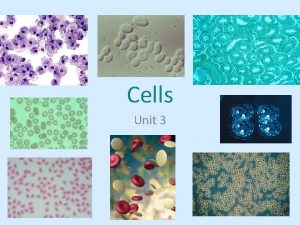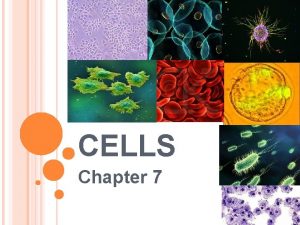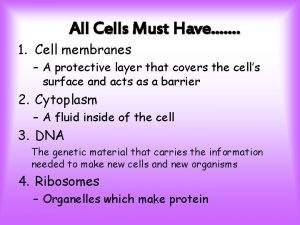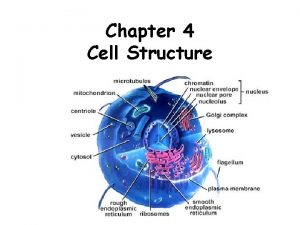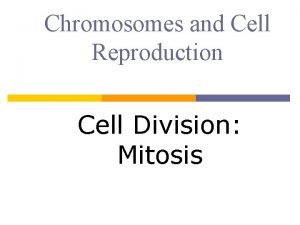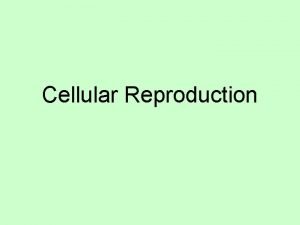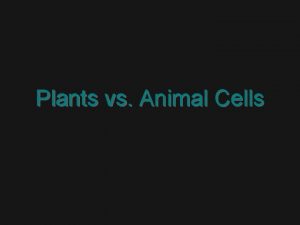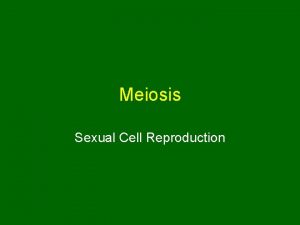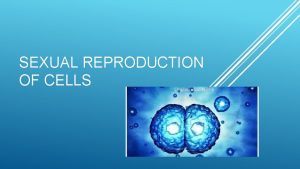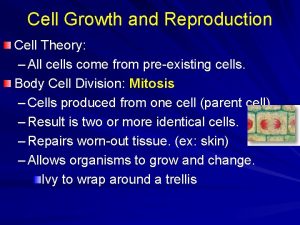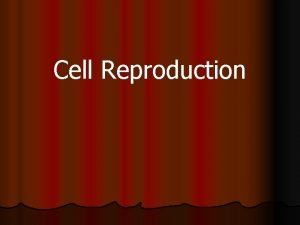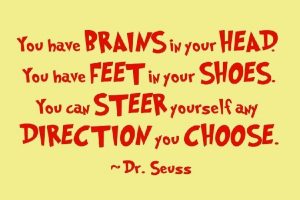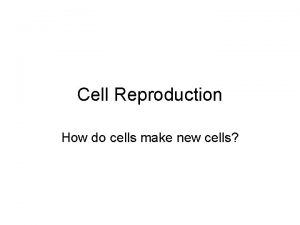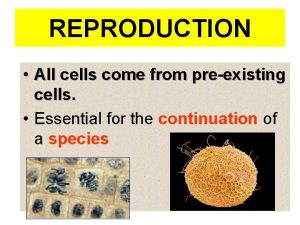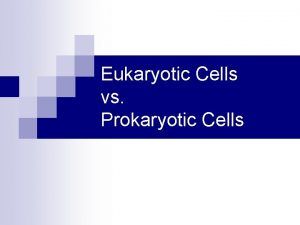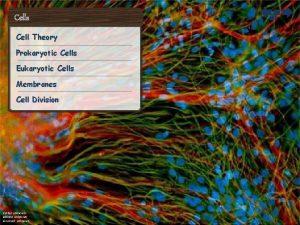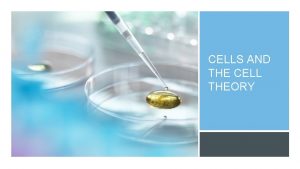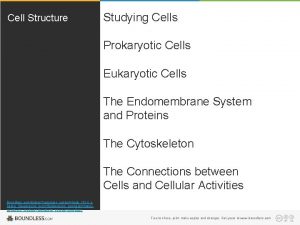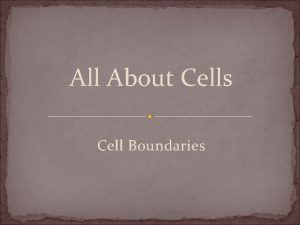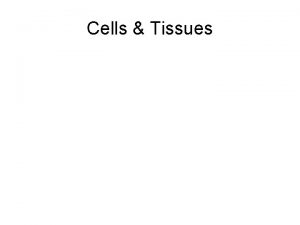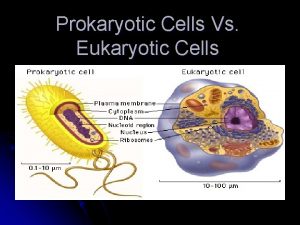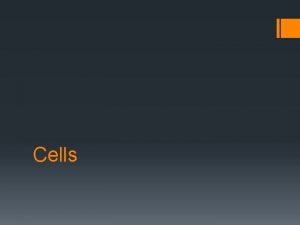Cell Reproduction Cell Reproduction n n All cells



























- Slides: 27

Cell Reproduction

Cell Reproduction n n All cells come from preexisting cells Cell division results in two daughter cells that are identical to the original cell, the parent cell Chromosomes are the carriers of genetic information that is copied and passed from generation to generation of cells Chromatin long strands of DNA wrapped around proteins

Why do cells reproduce? n n To maintain workable ratio of cell volume to cell surface area For organism growth , repair, and replacement of dead cells

Asexual vs Sexual Reproduction n n Asexual reproduction of offspring from one parent (NO variation in heredity) Sexual reproduction formation of new individuals from the union of two parent cells (Extreme variation in heredity)

Rate of Cell Division n Amount of resources determines rate (enough enzymes and proteins); environment conditions must be right n Bacteria- every 20 minutes n Skin Cell- 18 -22 hours

Prokaryotic Cell Division n Asexual production of offspring from one parent n n Binary fission- cells splits into two Spores- form a protective wall and remain inactive until conditions favorable Budding- cell divides into 2 cells of unequal size; bud pinches off to form new organism NO variation in heredity

Critical Questions n n n Name 3 reasons that cells must divide Which type of asexual reproduction would bacteria (a unicellular organism) use? After cells divide, would you expect them to be exact clones of each other?

Eukaryotic Cell Division n Eukaryotic cells divide by mitosis or meiosis n These cells have many chromosomes n n Mitosis generates two cells with the same genetic information as the original cell (asexual reproduction) Meiosis is the process in which the chromosome number is halved and some of the genes are shuffled (sexual reproduction)

The Cell Cycle n Interphase n Mitosis n n Prophase Anaphase Telophase Cytokinesis

Interphase n DNA is copied and it is the busiest part of the cell cycle n n n G 1 phase protein synthesis is rapidly occurring as the cell grows and develops S Stage the chromosomes are replicated in the nucleus. Chromosomes divide to form identical sister chromatids connected by a centromere G 2 phase cell organizes and prepares for mitosis

Critical Questions n n Why must the DNA be copied during interphase? What phase divides the chromosome into 2 sister chromatins?

Mitosis n 4 phases

Prophase n n n Chromosomes appear and spindle forms Centrioles move to opposite poles Spindle fibers begin to stretch across the nucleus

Metaphase n n Chromosomes line up across the equator Spindle fibers attach at the centromere

Karyotypes n n The number, shapes, and sizes of the metaphase chromosomes constitute the karyotype Some genetic abnormalities can be identified using karyotyping (ex. Down syndrome)

Anaphase n n Spindle fibers contract pulling apart the chromosome Divided chromosomes move to the opposite poles

Telephase n n n Nucleus beings to pull apart Chromosome disappear Two nuclei are then formed

Cytokinesis n Cytoplasm divides and two identical daughter cells are formed

Critical Question n How is mitosis important to a doctor studying cancer?

Meiosis (Sexual Reproduction) n n Two parents each contribute a set of chromosomes through gametes to form a zygote Gametes (sex cells) must have only half of the normal number of chromosomes (diploid) Meiosis produces gametes by dividing the chromosomal material in half and making 4 haploid cells Homologous Chromosome have generally but not identically the same genetic information n n Haploid cells n Diploid cells 2 n

Stages of Meiosis n Prophase II n Metaphase II n Anaphase II n Telephase II

n n First Meiotic division Prophase I similar to prophase in mitosis except that homologous chromosomes will pair up and crossing over will occur Metaphase I homologous chromosomes line up at the equator RANDOMLY Anaphase. I chromatids separate Telephase I no movement of chromosomes, nuclear envelope re-forms

Second Meiotic Divsion n n Prophase II no additional replication has occurred. Nuclear envelope disintegrates Metphase. II chromosomes line-up at the equator, spindles attach to the centromeres Anaphase II chromatids separate Telophase II nuclear envelope reforms

Chromosome Number Comparison Humans have 23 chromosomes

Human Chromosomes n n Exist in homologous pairs (code for the same trait) Human body cells (somatic cells) have 23 pairs for a total of 46 chromosomes n n n Pairs 1 -22 are called autosomes Pair 23 are the sex chromosomes Half of each homologous pair came from on parent after segregation and the other half from the other parent

Difference in Mitosis and Meiosis MITOSIS n n Used to produce body cells Daughter cell identical to parent End result is 2 diploid cells Uses only 1 division MEIOSIS n n Used to produce sex cells Daughters have half the chromosomes of the parent End result is 4 haploid cells Uses 2 divisions

Chromosomal Mutations n n n Deletion part f the chromosome is left out Translocation part of a chromosome breaks off and is added to another Inversion part of a chromosome breaks off an is reinserted backwards
 Nondisjunction in meiosis
Nondisjunction in meiosis Asexual reproduction cell division
Asexual reproduction cell division Asexualk
Asexualk Asexual vs sexual reproduction venn diagram
Asexual vs sexual reproduction venn diagram Olfactory groove keros classification
Olfactory groove keros classification Tubular secretion
Tubular secretion Parafollicular
Parafollicular Somatic cells vs gametes
Somatic cells vs gametes Why dna is more stable than rna?
Why dna is more stable than rna? Chlorocruorin
Chlorocruorin Eukaryotic vs prokaryotic cells
Eukaryotic vs prokaryotic cells Venn diagram animal and plant cells
Venn diagram animal and plant cells Prokaryotic cells vs eukaryotic cells
Prokaryotic cells vs eukaryotic cells Why did robert hooke name cells “cells”?
Why did robert hooke name cells “cells”? Masses of cells form and steal nutrients from healthy cells
Masses of cells form and steal nutrients from healthy cells Pseudostratified vs simple columnar
Pseudostratified vs simple columnar Prokaryotic cells vs eukaryotic cells
Prokaryotic cells vs eukaryotic cells Which compares prokaryotes and eukaryotes
Which compares prokaryotes and eukaryotes Cell substance
Cell substance Opposite rays
Opposite rays Cell transport
Cell transport Tissue are grouped together to form various
Tissue are grouped together to form various All cells have
All cells have All cells must contain
All cells must contain All cells exhibit basic structural similarities
All cells exhibit basic structural similarities All cells must contain
All cells must contain Cell reproduction
Cell reproduction Asexual reproduction cell division
Asexual reproduction cell division




















